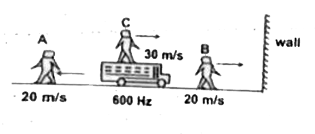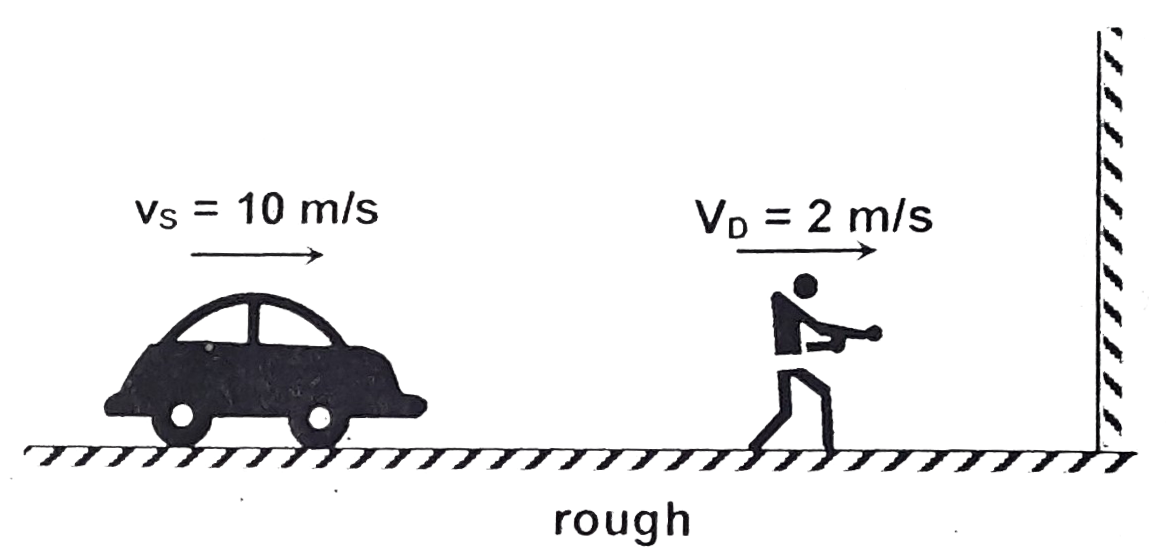A source of sonic oscillation with frequency n0=600Hz moves away and at right angles to a wall with velocity u=30ms. A stationary reciever is located on the line of source in succession wall→source→receiver. If velocity of osund propagation is v=330ms, then
Q. The wavelength of reflected waves received by the receiver is
beats frequency recorded by the receiver is 110 Hz
wavelengths of direct and reflected waves received by the receiver are 50 and 60 cm respectively
if receiver stands in between wall and source, beats recorded by the receiver is 0
if receiver stands between wall and source, then wavelengths of direct and reflected waves are 60 cm each
The correct Answer is:A, B, C, D
To solve the problem step by step, we will follow the principles of wave motion and the Doppler effect.
Step 1: Identify the given data
- Frequency of the source, n0=600Hz
- Velocity of the source moving away from the wall, u=30m/s
- Velocity of sound, v=330m/s
Step 2: Calculate the frequency of the reflected sound wave
When the source moves away from the wall, the frequency of the sound wave reflected back to the source can be calculated using the formula for the Doppler effect:
nr=n0vv+u
Substituting the values:
nr=600Hz×330m/s330m/s+30m/s
Step 3: Simplify the equation
Calculate the denominator:
nr=600Hz×330360
Step 4: Perform the calculations
Now, simplify the fraction:
nr=600Hz×1112
Calculating this gives:
nr=600×0.9167≈550Hz
Step 5: Calculate the wavelength of the reflected waves
The wavelength λ of the reflected waves can be calculated using the formula:
λ=vnr
Substituting the values:
λ=330m/s550Hz
Step 6: Perform the final calculation
Calculating this gives:
λ=0.6m
Step 7: Convert to centimeters
To express the wavelength in centimeters:
λ=0.6m×100=60cm
Final Answer:
The wavelength of the reflected waves received by the receiver is 60cm.
---
- Frequency of the source, n0=600Hz
- Velocity of the source moving away from the wall, u=30m/s
- Velocity of sound, v=330m/s
When the source moves away from the wall, the frequency of the sound wave reflected back to the source can be calculated using the formula for the Doppler effect:
Calculate the denominator:
Now, simplify the fraction:
The wavelength λ of the reflected waves can be calculated using the formula:
Calculating this gives:
To express the wavelength in centimeters:
The wavelength of the reflected waves received by the receiver is 60cm.
Topper's Solved these Questions
- WAVE MOTIONBook:VMC MODULES ENGLISHChapter:WAVE MOTIONExercise:JEE MAIN ARCHIVE LEVEL 1
Explore 56 Videos
- WAVE MOTIONBook:VMC MODULES ENGLISHChapter:WAVE MOTIONExercise:JEE ADVANCED ARCHIVE LEVEL 2
Explore 32 Videos
- WAVE MOTIONBook:VMC MODULES ENGLISHChapter:WAVE MOTIONExercise:LEVEL-1
Explore 75 Videos
- UNITS, MEASUREMENTS & ERRORSBook:VMC MODULES ENGLISHChapter:UNITS, MEASUREMENTS & ERRORSExercise:IN - CHAPTER EXERCISE - B
Explore 10 Videos
- WORK ENERGY AND POWER Book:VMC MODULES ENGLISHChapter:WORK ENERGY AND POWER Exercise:IMPECCABLE
Explore 54 Videos
Similar Questions
A source of sonic oscillation with frequency n0=600Hz moves away and at right angles to a wall with velocity u=30ms. A stationary reciever is located on the line of source in succession wall→source→receiver. If velocity of osund propagation is v=330ms, then
Q. The wavelength of direct waves received by the receiver is
View SolutionA source of sonic oscillation with frequency n0=600Hz moves away and at right angles to a wall with velocity u=30ms. A stationary reciever is located on the line of source in succession wall→source→receiver. If velocity of osund propagation is v=330ms, then
Q. The beat frequency recorded by the receiver is
View SolutionA source of sonic oscillations with frequency v0=100Hz moves at right angles to the wall with a velocity u=0.17m/s. Two stationary receivers R1 and R2 are located on a straight line, coinciding with the trajectory of the source , in the following succession :R1− source −R2− wall. Which receiver registers the beatings and what is the beat frequency ? The velocity of sound is equal to υ=340m/s.
View SolutionA source of sonic oscillations with frequency v0=100Hz moves at right angles to the wall with a velocity u=0.17m/s. Two stationary receivers R1 and R2 are located on a straight line, coinciding with the trajectory of the source , in the following succession :R1− source −R2− wall. Which receiver registers the beatings and what is the beat frequency ? The velocity of sound is equal to υ=340m/s.
View SolutionA source of sound of frequency 256 Hz moves rapidly towards a wall with a velocity of 5ms−1. How many beats per second will be heard if sound travels at a speed of 330 m/s?
View SolutionA source of sonic oscillations with frequency n=1700Hz and a receiver are located on the same normal to a wall. Both the source and receiver are stationary, and the wall recedes from the source with velocity u=6.0ms. Find the beat frequency registered by the receiver. The velocity of sound is v=340ms.
View SolutionA source of sonic oscillations with frequency n=1700Hz and a receiver are located on the same normal to a wall. Both the source and receiver are stationary, and the wall recedes from the source with velocity u=6.0ms. Find the beat frequency registered by the receiver. The velocity of sound is v=340ms.
View SolutionA source of sound which emitting a sound of frequency 600 Hz is moving towards a wall with a velocity 30 m/s. Three observes A, B, C moving with velocity 20 m/s, A away from the wall and B towards the wall and Inside the source, Velocity of sound in air is 330 m/s.

Find the frequency of reflected sound observed by observer B
View SolutionA source of sound of frequency 256Hz is moving rapidly towards wall with a velocity of 5m/sec. How many beats per second will be heard if sound travels at a speed of 330m/sec.
View SolutionA car is moving with a constant velocity 10m/s towards the stationary wall. The car blows a horn of frequency 320Hz. The velocity of sound in air is 330m/s. The beats frequency received by the observer is

View Solution
